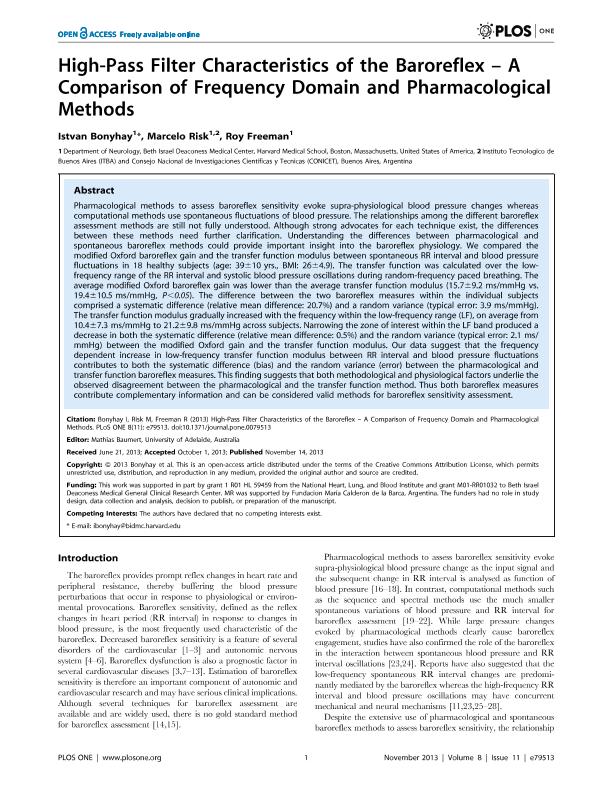Mostrar el registro sencillo del ítem
dc.contributor.author
Risk, Marcelo

dc.contributor.author
Bonyhay, Istvan
dc.contributor.author
Freeman, Roy
dc.date.available
2016-12-12T20:24:54Z
dc.date.issued
2013-11
dc.identifier.citation
Risk, Marcelo; Bonyhay, Istvan; Freeman, Roy; High-Pass Filter Characteristics of the Baroreflex - A Comparison of Frequency Domain and Pharmacological Methods; Public Library Of Science; Plos One; 8; e795; 11-2013; 1-12
dc.identifier.issn
1932-6203
dc.identifier.uri
http://hdl.handle.net/11336/9162
dc.description.abstract
Pharmacological methods to assess baroreflex sensitivity evoke supra-physiological blood pressure changes whereas computational methods use spontaneous fluctuations of blood pressure. The relationships among the different baroreflex assessment methods are still not fully understood. Although strong advocates for each technique exist, the differences between these methods need further clarification. Understanding the differences between pharmacological and spontaneous baroreflex methods could provide important insight into the baroreflex physiology. We compared the modified Oxford baroreflex gain and the transfer function modulus between spontaneous RR interval and blood pressure fluctuations in 18 healthy subjects (age: 39±10 yrs., BMI: 26±4.9). The transfer function was calculated over the low-frequency range of the RR interval and systolic blood pressure oscillations during random-frequency paced breathing. The average modified Oxford baroreflex gain was lower than the average transfer function modulus (15.7±9.2 ms/mmHg vs. 19.4±10.5 ms/mmHg, P<0.05). The difference between the two baroreflex measures within the individual subjects comprised a systematic difference (relative mean difference: 20.7%) and a random variance (typical error: 3.9 ms/mmHg). The transfer function modulus gradually increased with the frequency within the low-frequency range (LF), on average from 10.4±7.3 ms/mmHg to 21.2±9.8 ms/mmHg across subjects. Narrowing the zone of interest within the LF band produced a decrease in both the systematic difference (relative mean difference: 0.5%) and the random variance (typical error: 2.1 ms/mmHg) between the modified Oxford gain and the transfer function modulus. Our data suggest that the frequency dependent increase in low-frequency transfer function modulus between RR interval and blood pressure fluctuations contributes to both the systematic difference (bias) and the random variance (error) between the pharmacological and transfer function baroreflex measures. This finding suggests that both methodological and physiological factors underlie the observed disagreement between the pharmacological and the transfer function method. Thus both baroreflex measures contribute complementary information and can be considered valid methods for baroreflex sensitivity assessment.
dc.format
application/pdf
dc.language.iso
eng
dc.publisher
Public Library Of Science

dc.rights
info:eu-repo/semantics/openAccess
dc.rights.uri
https://creativecommons.org/licenses/by-nc/2.5/ar/
dc.subject
Heart Rate Vriability
dc.subject
Baroreflex
dc.subject
Transfer Functions
dc.subject
Blood Pressure
dc.subject.classification
Fisiología

dc.subject.classification
Medicina Básica

dc.subject.classification
CIENCIAS MÉDICAS Y DE LA SALUD

dc.title
High-Pass Filter Characteristics of the Baroreflex - A Comparison of Frequency Domain and Pharmacological Methods
dc.type
info:eu-repo/semantics/article
dc.type
info:ar-repo/semantics/artículo
dc.type
info:eu-repo/semantics/publishedVersion
dc.date.updated
2016-11-24T18:38:46Z
dc.journal.volume
8
dc.journal.number
e795
dc.journal.pagination
1-12
dc.journal.pais
Estados Unidos

dc.journal.ciudad
San Francisco
dc.description.fil
Fil: Risk, Marcelo. Harvard Medical School; Estados Unidos
dc.description.fil
Fil: Bonyhay, Istvan. Harvard Medical School; Estados Unidos
dc.description.fil
Fil: Freeman, Roy. Harvard Medical School; Estados Unidos. Instituto Tecnologico de Buenos Aires; Argentina. Consejo Nacional de Investigaciones Científicas y Técnicas; Argentina
dc.journal.title
Plos One

dc.relation.alternativeid
info:eu-repo/semantics/altIdentifier/url/http://journals.plos.org/plosone/article?id=10.1371/journal.pone.0079513
dc.relation.alternativeid
info:eu-repo/semantics/altIdentifier/url/https://www.ncbi.nlm.nih.gov/pmc/articles/PMC3828383/
dc.relation.alternativeid
info:eu-repo/semantics/altIdentifier/doi/http://dx.doi.org/10.1371/journal.pone.0079513
Archivos asociados
